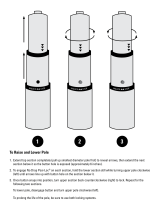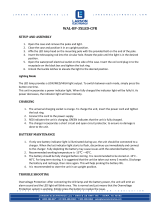
3INSTALLATION AND OPERATION INSTRUCTIONS MN280082EN July 2018
Form 6-LS microprocessor-based pole mount recloser control
FORM 6-LS recloser control description
Description
The Form 6-LS pole-mount microprocessor-based
recloser control includes extensive auto-reconfiguration
system protection functionality, including phase, ground,
and negative sequence overcurrent protection, over/
underfrequency, and voltage protection, directionality,
sensitive ground fault, and sync check.
The control is for application in distribution feeder loop
sectionalizing schemes. The Form 6-LS control senses
the loss of voltage, and after a predetermined time delay,
performs the programmed action to restore service to the
affected feeder.
The control can be programmed for either the sectionalizing
or tie mode of operation. The sectionalizing mode senses
voltage on the source side of a normally closed recloser and
is activated upon loss of source-side voltage. The tie mode
of operation senses voltage on both sides of a normally
open recloser and is activated upon loss of voltage on either
side. The tie mode is used for both one-way and two-way
tie applications.
Analysis tools include fault locating, event recording, TCC
Editor II, Idea Workbench, Data Profiler, and oscillography
functions, including oscillography replay.
Metering functions include demand and instantaneous
current on a per-phase basis, instantaneous voltage and
power factor on a per-phase basis, and power (real, reactive,
apparent) on a per phase or total basis. Symmetrical
components for both voltage and current are displayed
along with kilowatt-hours for energy metering. Harmonics
from the 2
nd
to the 15
th
harmonic are also included.
The front panel LCD display is used to configure the
operating settings for the control. It is also used to display
metering, counter information, control parameters, reset
alarms, and provide diagnostic information.
Control parameters can also be programmed via a personal
computer connected to the control through the front panel
RS-232 port. Control programming, interrogation, and
operations are performed with Form 6 ProView interface
software on a personal computer.
ProView interface program software includes additional
functions used to create and graphically display Time
Current Curves and provides the Idea Workbench for
configuring user-selected inputs and outputs, configurable
event and alarm data, and selectable communication points
for serial communication.
The control operates on 50 and 60 Hz systems.
The control can be configured, by the factory or by the
user, for a wide variety of applications. If user requirements
change, the control functions can be modified to meet the
new requirements.
The control is accessible from both the front and back of
the cabinet (Figure1).
Figure1. Form 6-LS pole mount recloser control is
accessible from both the front and back of the cabinet
Theory of operation
A functional block diagram of the Form 6-LS recloser control
is shown in Figure2. Current sensing is provided by three
current transformers located in the recloser and interfaced
to the Form 6 recloser control via the control cable. This
cable also supplies Trip, Close, and Recloser status, and
connects to the Recloser Interface (RIF) module to provide
isolation for reliable operation. Voltages for metering are
connected to the analog input module through terminal
block TB8.
Line current flowing through the recloser is converted by
the CPU module to a digital signal suitable for metering and
fault current calculations. Data sampling occurs at a rate
of 64 times per cycle. The CPU contains a data acquisition
section that uses the acquired samples to compute the
fundamental currents and voltage for use in overcurrent,
under/overvoltage, and under/overfrequency protection,
as well as currents and voltages for metering functions.
The current for overcurrent protection is calculated on a
sub-cycle basis; it includes only the fundamental and
DC component.
When the phase or ground current exceeds its programmed
minimum-trip value and associated time-current-curve (TCC)
timing, the control initiates the programmed sequence of
recloser tripping and reclosing operations via the CPU and
RIF modules. If the fault is temporary, the control ceases
to command recloser operations after a successful reclose,
and the control resets to the start of its operating sequence
after a preset time delay. If the fault is permanent, the
control performs its complete programmed sequence of
reclose commands and locks out with the recloser open.
Once locked out, the control must be closed via the
operator panel or SCADA communications. This resets the
control to the start of the operating sequence.
The following chain of events occurs for an operating
sequence of two trips to lockout (one trip on TCC1, one trip
on TCC2):
1. The overcurrent signal is integrated with time on the
selected curve for the first trip operation (TCC1) to
produce the signal which energizes the trip circuit.





















